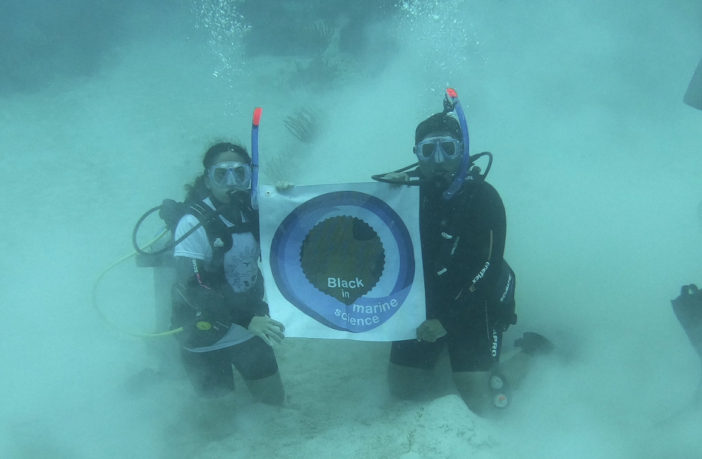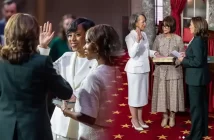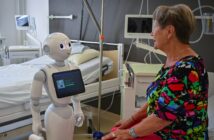By Ariyana Griffin,
Special to the AFRO
When Dr. Tiara Moore, an environmental ecologist, took to Twitter to look for more Black marine scientists in 2020, she had no idea it would lead to a forceful movement and the founding of a new organization, Black In Marine Science (BIMS).
“I realized that we might be the only Black person in our one lab, but there are a thousand labs. So if it’s one of us [in]each of those labs– it’s a thousand of us–and we could make a movement,” Moore said.
What started out to be a week of events to raise awareness, organize and build community turned into a nonprofit that amplifies Black voices in the field and the classroom. Today, BIMS is a collective of Black marine scientists who want to shed light on the diversity issue in their industry, while also working to change it for the future generations.
Marine science is a major umbrella term, but the predominantly White industry lacks diversity. According to the Integrated Postsecondary Education Data System, Black graduates represent approximately two percent of all degrees in Marine Sciences earned from 2002-2017.
“Diversity in marine science is important because we know who environmental injustice or environmental changes are impacting the most,” said Dr. Moore. “Climate change, nutrient pollution, sea level rise– all these big words that you hear in the media– are impacting Black and Brown communities more.”
The effects on marine life and structures can be detrimental for communities of color, as these communities are prone to pollution, unsatisfactory water and air quality and many other factors at a disportunate rate.
Vernon Smith, the National Media Coordinator at the National Oceanic Atmospheric Administration’s (NOAA) Office of National Marine Sanctuaries, explained that the work BIMS is doing is vital due to the state the planet is in today.
“Our planet is under tremendous pressure from major stressors like climate change,” said Smith. “By engaging historically underrepresented communities and individuals in marine and ocean conservation, we can help encourage and support grassroots stewardship and implement more effective conservation and management policies.”
Mark Losavio, vice chair and marine archaeologist, explained that often the aftermath of climate change issues are left with communities of color to deal with.
“A lot of times that stuff is just like a downstream problem and our communities are often located where those consequences happen,” Losavio said.
Careers in marine science
Marine science has various career paths that people may be interested in,they just may not know they exist.
It can range from biologists, ecologists, journalists, videographers “underwater photographers, scientists that work with microbes, people that make maps of the sea floor,” explained Queriah “Que” Simpson, the senior director of membership and program operations for BIMS.
Simpson, and an environmental scientist, has been hands on when it comes to logistics and programming. She helps the organization prepare for conference events, communicating with donors and funders to ensure that they have grants and the budgets to maintain the work that they do. She also has a hand in building invigorating curriculums and programs to inspire the minds of the next generation.
“I’ve been able to use one of the DEIA (diversity, equity, inclusion and accessibility) grants we just got from the National Marine Sanctuary Foundation to put together a program with another nonprofit organization that I’m on the executive board for, called Little Growers,” said Simpson. Little Growers is located in South Brevard County, Fla.
“We will be hosting a three day marine science immersive learning experience for them,” she added.
The program will allow teens to get some hands-on experience at the Indian River Lagoon and learn about marine science in real time.
Representation in the marine science industry
“I didn’t have anybody like me in my community doing what I was doing,” said Simpson. “We have a lot of students that don’t know how to swim or have their little extra concerns about being in the water that we’re, we’ve been able to dispel certain myths and get more people comfortable with being in the water.”
BIMS has several opportunities for people to learn about what goes on under the sea. Recently, they hosted a screening of Disney’s live action “The Little Mermaid” recently in Hampton, Va.
The organization allows Black marine scientists access to workshops, general body meetings, game nights and other networking opportunities. Past events have also included discussions with experts like Dr. Dawn Wright, the first Black woman to go Challenger Deep– which is the deepest-known point of the sea. Moore explained that Wright was able to share things that other marine scientists may have never thought of, such as how she took care of her hair while preparing to dive.
“We had her come on and talk about her experience going in the submarine, how she prepared, how she took care of her hair. We bring on Black marine science experts and talk about what they do in their research, but then [we]talk about what humanizes them and how they navigate these spaces,” said Moore.
The organization does more than focus on its direct community– they are also committed to giving back to the community and providing youth with opportunities in the field. Symone Barkley, the chief learning officer and marine biologist, regularly visits schools in the Baltimore area to teach them about what marine scientists do.
Barkley did some work and research around Sand Tiger Sharks, a protected species, in the Delaware Bay to decrease instances of them from being hooked by fishermen.
“They end up catching them and the hook gets lodged really deep internally into the shark, which can cause internal bleeding. It can lead to additional injury or mortality to the sharks,” said Barkley. “The work that I did was focused [on]trying to figure out some kind of material or some kind of gear we could use to prevent the shark from swallowing the hook whole.”
While she loved her work in the field, Barkley knew she wanted to make everything come full circle and provide opportunities for younger people who looked like her.
“I love seeing their faces when we’re talking about something, or they are holding an animal in their hand,” she said. “I love being able to give our kids those opportunities because other kids have those opportunities every single day.”
She explained that they have scuba diving classes that help students get comfortable underwater and even certified.
“We have scuba diving classes where young people are able to attend a scuba diving class with us and they don’t need to pay to attend the class– it’s free. We take care of the housing, the food, any of the equipment, the travel, those things are all covered by us,” Barkley said.
These are just one of many ways the organization provides accessible opportunities for communities. For five years Barkley managed the education programs at the National Aquarium, developed a curriculum and trained teachers. There is also a new program in place for all the sixth-grade students in Baltimore City to learn more about the Chesapeake Bay Watershed.
BIMS also provides opportunities for young people to create an episode on their BIMS Bites and BIMS Bites Kids websites, which offers informational programming for free.
To find out more about the programs that they offer and to get involved please visit, blackinmarinescience.org and follow them on Twitter @BlackinMarSci.



